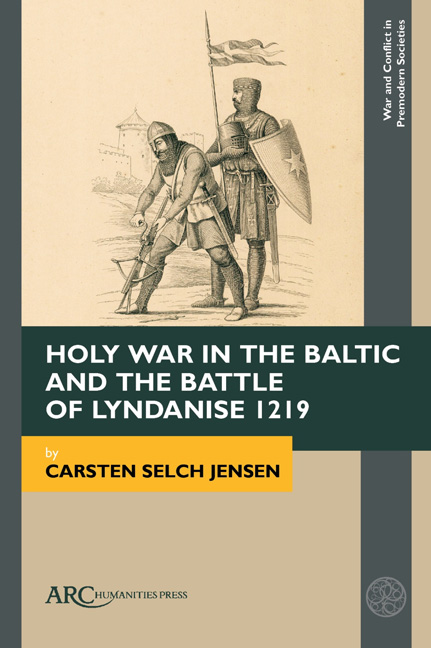Book contents
- Frontmatter
- Contents
- List of Illustrations
- Acknowledgments
- Introduction. Holy War in the Baltic and the Battle of Lyndanise 1219
- Chapter 1 Foreign Shores—Foreign People: The Medieval Baltic and its People
- Chapter 2 Fighting God’s War: Papal Crusading Politics in the Baltic from the Early 1100s until the Early 1200s
- Chapter 3 A Society Organized for War: Denmark at the Beginning of the Thirteenth Century
- Chapter 4 Competing Powers: The German Mission in Livonia and the Initial Quest for Estonia
- Chapter 5 Waging War in the Wilderness: Western Military Traditions Meet Baltic Traditions
- Chapter 6 The Danish Expedition to Estonia in 1219 and the Battle of Lyndanise
- Chapter 7 Conquering Hearts and Minds: The Aftermath of the Battle
- Conclusion A Penny in the Box: How Estonia Came to Save Denmark
- Select Bibliography
- Index
Chapter 5 - Waging War in the Wilderness: Western Military Traditions Meet Baltic Traditions
Published online by Cambridge University Press: 08 May 2024
- Frontmatter
- Contents
- List of Illustrations
- Acknowledgments
- Introduction. Holy War in the Baltic and the Battle of Lyndanise 1219
- Chapter 1 Foreign Shores—Foreign People: The Medieval Baltic and its People
- Chapter 2 Fighting God’s War: Papal Crusading Politics in the Baltic from the Early 1100s until the Early 1200s
- Chapter 3 A Society Organized for War: Denmark at the Beginning of the Thirteenth Century
- Chapter 4 Competing Powers: The German Mission in Livonia and the Initial Quest for Estonia
- Chapter 5 Waging War in the Wilderness: Western Military Traditions Meet Baltic Traditions
- Chapter 6 The Danish Expedition to Estonia in 1219 and the Battle of Lyndanise
- Chapter 7 Conquering Hearts and Minds: The Aftermath of the Battle
- Conclusion A Penny in the Box: How Estonia Came to Save Denmark
- Select Bibliography
- Index
Summary
THE MILITARY CONQUEST of both Livonia and Estonia was, by all accounts, an extremely brutal affair, characterized by a high level of violence. We have already touched upon the practices of raiding and plundering enemy lands, taking as much booty as possible while enslaving the local people. This type of warfare was carried out both by land and by sea enabling attacks deep into enemy territory and involving pretty much everybody in the region. Largescale campaigns were fought with little regard to enemy lives or properties. Often, men of fighting age were seemingly killed right away, according to contemporary sources like Henry of Livonia, whereas women and children were taken captive to be sold as slaves at one of the local slave markets or shipped off to foreign lands never to see their ancestral homes again. Even fellow Christians ran the risk of becoming entrapped during these wars, especially if the enemy belonged to a dif-ferent denomination as we have already seen with the German-Rus’ relations between whom there were very little reverence or respect.
Neither the German nor the Danish crusaders brought warfare to a region other-wise untouched by this favoured pastime of mankind—far from it. Various forms of con-tinual warfare with raids and larger military expeditions into enemy territory seem to have been the norm for generations among the Baltic people, predating the arrival of the Western crusaders and their novel ideas of holy wars and crusades. As such, martial cultures were strong among most of the local people. For their part, Western crusaders would have been unable to subjugate these vast territories had it not been for the direct and active support of the locals who, for one reason or the other, chose to side with the powerful newcomers in their continuous struggle against age-old local enemies, and, thereby, gain military advantage. Like in so many other crusading theatres along the fringes of Christendom, it was, by no means, the crusaders who introduced the art of war among the local people. Rather, the crusaders became (new) players in already existing power struggles and age-old feuds.
- Type
- Chapter
- Information
- Holy War in the Baltic and the Battle of Lyndanise 1219 , pp. 73 - 102Publisher: Amsterdam University PressPrint publication year: 2024

